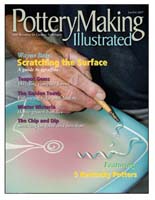|
|
Sgraffito
is the cutting through of one color layer to expose the underneath
color. The colors I use are applied as a colored clay coating
called an engobe and are sprayed on the leather hard porcelain
before it is fired. I use automotive type spray equipment,
and what is called a "detail gun". The colors are
sprayed in circular bands that follow the shape of the pot
and the gradations and blends that occur naturally are part
of what makes the color work. I tend to use color sets, such
as, black/green/yellow and crimson, and allow the colors to
overlap each other. The water in the engobe softens the porcelain,
so it has to harden again to leather hard before it can be
carved. |
|
|
When
the pot has become leather hard again, it goes back to the
potters wheel and lines that are circularly continuous are
cut through the engobe while the wheel is spinning. This cutting
is done with a tool made from the spring wire of a pocket watch,
and one or many lines or spirals can be made. |
|
|
The other
lines are done free hand and an infinite variety of lines
and shapes can be carved into the surface. This is sgraffito,
the cutting or scraping away of one color to expose another
underneath color. We all did sgraffito in school when we
rubbed many crayon colors onto paper then covered it with
black crayon, and scratched it away to get a multi-colored
line. I do sgraffito through engobes on porcelain.
|
|
|
When
the basic shapes or patterns are carved, the large areas of
white are made by scraping away all the color. Using a larger
wire tool, this area can be smooth or textured although it
will all be white. This step takes a lot of time if a large
area is exposed and is the last step of sgrafftio. |
|
|
The
sgraffito is the fun part for me. I enjoy making the shapes,
but laying out the designs and seeing them appear right before
my eyes is always a great pleasure. Each pot with its colored
coating is a chance for me to explore the surface with lines
and shapes and patterns. These designs are part of the surface
but also reveal a core shape. It is this tension between form
and surface that is endlessly fascinating for me. As I sgraffito,
I remove the color which is darker and expose the porcelain
that is white and lighter than the engobe. It is a way to find
the light. After the pot dries thoroughly, it goes through
a bisque firing that hardens the clay so that it cannot be
dissolved with water. The glaze materials are suspended in
water and applied as a solution, but because of the bisque
firing the water does not dissolve the clay. |
|
|
The
glaze coating is made up of materials that will form a
type of glass or glaze when fired in the kiln. It takes
time and temperature for this fusing or vitrification to
occur. Although I have fired my kiln thousands of times
I still am excited by the possibilities of each firing.
This transformation has aspects of transcendence and has
a meaning beyond the mechanics of the process. I hope each
piece is interesting to the minds eye, and a good example
of what is possible with this process and these materials.
Back To Home
|
|
Click on magazine
cover for my article
on making square plate and doing sgraffito.
 |
|